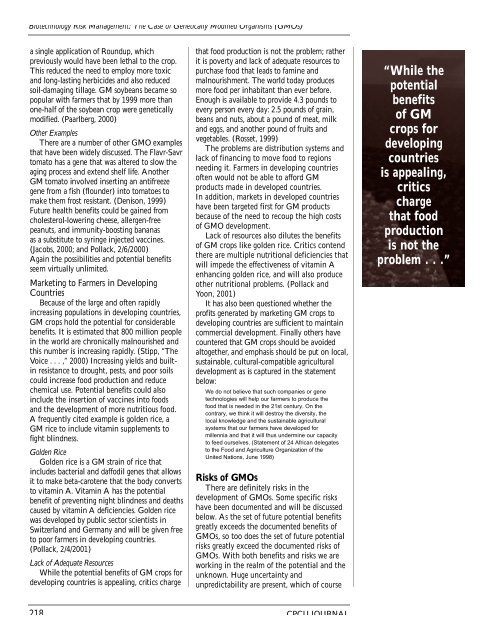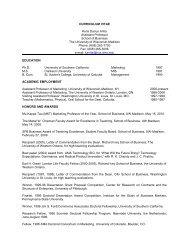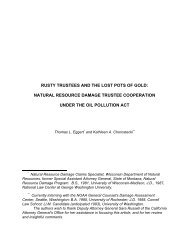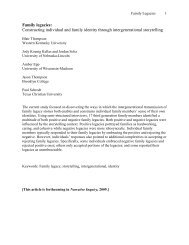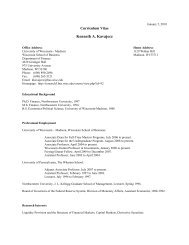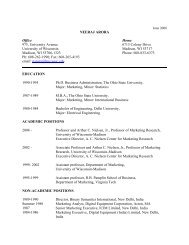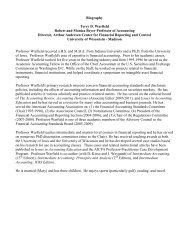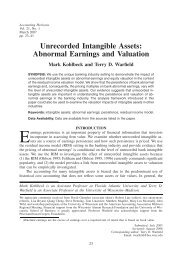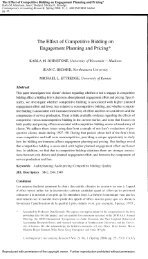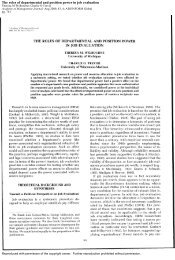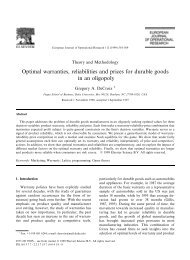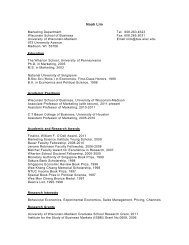by Dan R. Anderson, Ph.D.,CPCU - Wisconsin School of Business ...
by Dan R. Anderson, Ph.D.,CPCU - Wisconsin School of Business ...
by Dan R. Anderson, Ph.D.,CPCU - Wisconsin School of Business ...
Create successful ePaper yourself
Turn your PDF publications into a flip-book with our unique Google optimized e-Paper software.
Biotechnology Risk Management: The Case <strong>of</strong> Genetically Modified Organisms (GMOs)<br />
a single application <strong>of</strong> Roundup, which<br />
p reviously would have been lethal to the cro p .<br />
This reduced the need to employ more toxic<br />
and long-lasting herbicides and also re d u c e d<br />
soil-damaging tillage. GM soybeans became so<br />
popular with farmers that <strong>by</strong> 1999 more than<br />
one-half <strong>of</strong> the soybean crop were genetically<br />
m odified. (Paarlberg, 2000)<br />
Other Examples<br />
T h e re are a number <strong>of</strong> other GMO examples<br />
that have been widely discussed. The Flavr- S a v r<br />
tomato has a gene that was altered to slow the<br />
aging process and extend shelf life. Another<br />
GM tomato involved inserting an antifre e z e<br />
gene from a fish (flounder) into tomatoes to<br />
make them frost resistant. (Denison, 1999)<br />
F u t u re health benefits could be gained fro m<br />
c h o l e s t e rol-lowering cheese, allerg e n - f re e<br />
peanuts, and immunity-boosting bananas<br />
as a substitute to syringe injected vaccines.<br />
(Jacobs, 2000; and Pollack, 2/6/2000)<br />
Again the possibilities and potential benefits<br />
seem virtually unlimited.<br />
Marketing to Farmers in Developing<br />
C o u n t r i e s<br />
Because <strong>of</strong> the large and <strong>of</strong>ten rapidly<br />
i n c reasing populations in developing countries,<br />
GM crops hold the potential for considerable<br />
benefits. It is estimated that 800 million people<br />
in the world are chronically malnourished and<br />
this number is increasing rapidly. (Stipp, “The<br />
Voice . . . ,” 2000) Increasing yields and builtin<br />
resistance to drought, pests, and poor soils<br />
could increase food production and re d u c e<br />
chemical use. Potential benefits could also<br />
include the insertion <strong>of</strong> vaccines into foods<br />
and the development <strong>of</strong> more nutritious food .<br />
A frequently cited example is golden rice, a<br />
GM rice to include vitamin supplements to<br />
fight blindness.<br />
Golden Rice<br />
Golden rice is a GM strain <strong>of</strong> rice that<br />
includes bacterial and daff odil genes that allows<br />
it to make beta-carotene that the body convert s<br />
to vitamin A. Vitamin A has the potential<br />
benefit <strong>of</strong> preventing night blindness and deaths<br />
caused <strong>by</strong> vitamin A deficiencies. Golden rice<br />
was developed <strong>by</strong> public sector scientists in<br />
Switzerland and Germany and will be given fre e<br />
to poor farmers in developing countries.<br />
(Pollack, 2/4/2001)<br />
Lack <strong>of</strong> Adequate Resourc e s<br />
While the potential benefits <strong>of</strong> GM crops for<br />
developing countries is appealing, critics charg e<br />
that food production is not the problem; rather<br />
it is poverty and lack <strong>of</strong> adequate re s o u rces to<br />
p u rchase food that leads to famine and<br />
malnourishment. The world today prod u c e s<br />
m o re food per inhabitant than ever before .<br />
Enough is available to provide 4.3 pounds to<br />
e v e ry person every day: 2.5 pounds <strong>of</strong> grain,<br />
beans and nuts, about a pound <strong>of</strong> meat, milk<br />
and eggs, and another pound <strong>of</strong> fruits and<br />
vegetables. (Rosset, 1999)<br />
The problems are distribution systems and<br />
lack <strong>of</strong> financing to move food to regions<br />
needing it. Farmers in developing countries<br />
<strong>of</strong>ten would not be able to afford GM<br />
products made in developed countries.<br />
In addition, markets in developed countries<br />
have been targeted first for GM products<br />
because <strong>of</strong> the need to recoup the high costs<br />
<strong>of</strong> GMO development.<br />
Lack <strong>of</strong> resources also dilutes the benefits<br />
<strong>of</strong> GM crops like golden rice. Critics contend<br />
there are multiple nutritional deficiencies that<br />
will impede the effectiveness <strong>of</strong> vitamin A<br />
enhancing golden rice, and will also produce<br />
other nutritional problems. (Pollack and<br />
Yoon, 2001)<br />
It has also been questioned whether the<br />
p r<strong>of</strong>its generated <strong>by</strong> marketing GM crops to<br />
developing countries are sufficient to maintain<br />
c o m m e rcial development. Finally others have<br />
c o u n t e red that GM crops should be avoided<br />
a l t o g e t h e r, and emphasis should be put on local,<br />
sustainable, cultural-compatible agricultural<br />
development as is captured in the statement<br />
b e l o w :<br />
We do not believe that such companies or gene<br />
technologies will help our farmers to produce the<br />
food that is needed in the 21st century. On the<br />
contrary, we think it will destroy the diversity, the<br />
local knowledge and the sustainable agricultural<br />
systems that our farmers have developed for<br />
millennia and that it will thus undermine our capacity<br />
to feed ourselves. (Statement <strong>of</strong> 24 African delegates<br />
to the Food and Agriculture Organization <strong>of</strong> the<br />
United Nations, June 1998)<br />
Risks <strong>of</strong> GMOs<br />
There are definitely risks in the<br />
development <strong>of</strong> GMOs. Some specific risks<br />
have been documented and will be discussed<br />
below. As the set <strong>of</strong> future potential benefits<br />
greatly exceeds the documented benefits <strong>of</strong><br />
GMOs, so too does the set <strong>of</strong> future potential<br />
risks greatly exceed the documented risks <strong>of</strong><br />
GMOs. With both benefits and risks we are<br />
working in the realm <strong>of</strong> the potential and the<br />
unknown. Huge uncertainty and<br />
unpredictability are present, which <strong>of</strong> course<br />
218 <strong>CPCU</strong> JOURNAL<br />
“While the<br />
potential<br />
benefits<br />
<strong>of</strong> GM<br />
crops for<br />
developing<br />
countries<br />
is appealing,<br />
critics<br />
charge<br />
that food<br />
production<br />
is not the<br />
problem . . .”


